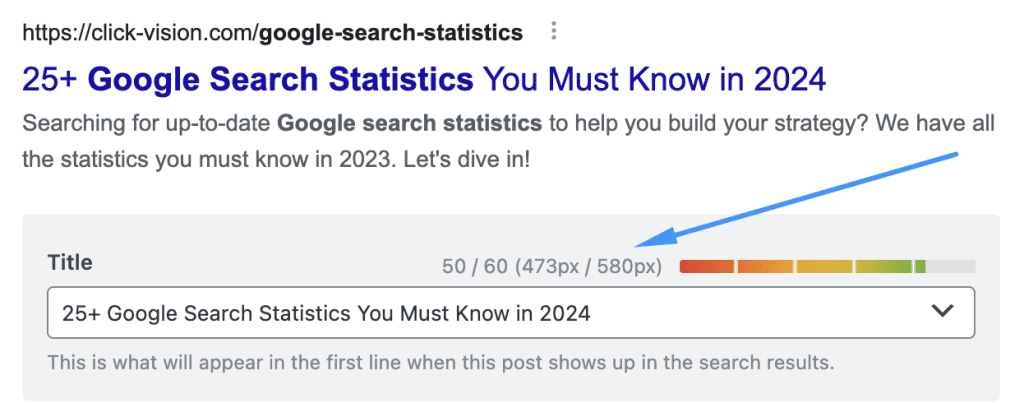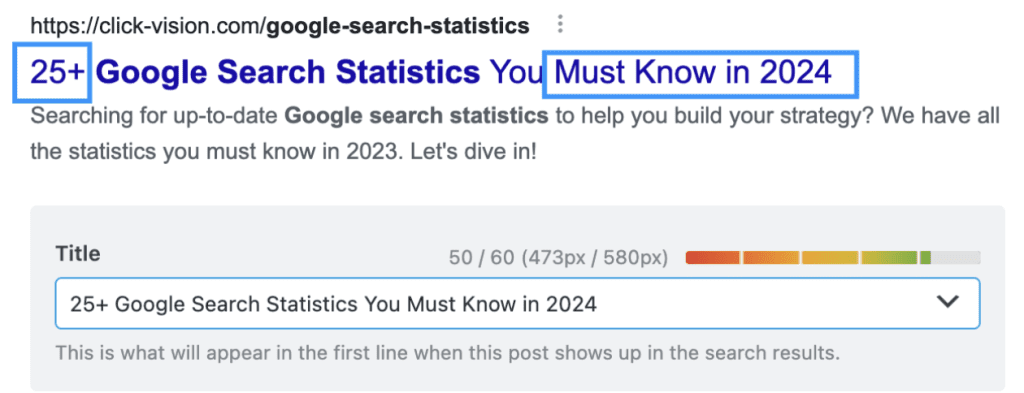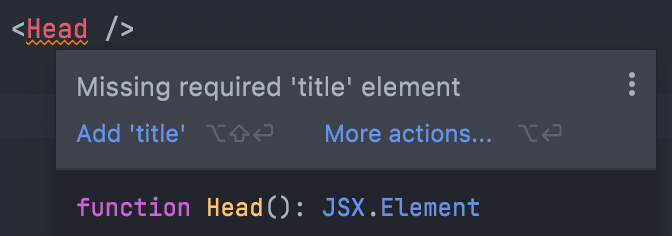Search engine optimization is an essential part of any successful online business. While it may sound simple, there are many details behind crafting the ideal SEO strategy. One such practice is title tag optimization, which inexperienced business owners often overlook. So, we want to elaborate on the use of title tags and the best practices for their optimization.
With CLICKVISION SEO’s experience in the field, we’ll highlight the importance and key components of this valuable element. We’ll also discuss some of the most common mistakes we’ve seen businesses make without even realizing it.
Continue reading to discover the best optimization practices for title tags and their importance!
What Is a Title Tag?
In simple words, a title tag is an HTML element that’s used to specify the title of a specific web page. While it’s commonly referred to as a <title> tag, some call it an SEO title, meta title, or SEO page title, even though that’s not completely correct. Since the main use of this element is to provide an accurate and concise description of the page’s content, it should never be overlooked.
Why are title tags important?
Since these elements are meant to provide a concise description of the page’s content, they influence the following SEO factors:
- Website ranking
- Appear in SERPs
- Link previews
- Browser tabs
Website ranking
The main reason why many businesses tend to optimize their title tags is because they can affect their ranking opportunities. Since the title tag is used to portray the page’s content, it’s easier for the search engines to understand what the page is about. Therefore, whenever a user searches for a topic relevant to the content on your page that’s displayed in the title tag, it’ll more likely appear in the search results.
Appear in SERPs
The page’s title tag will appear on the search engine results page as a clickable link that redirects the users to the page. If the search engine believes that your title doesn’t meet the user’s search intent, they may change your title to a more suitable option. Thus, having an optimized title tag will significantly affect your click-through rate and the user’s perception of your business.

Link previews
Choosing the appropriate title tag is also important when sharing the page across multiple platforms, such as messaging apps and social media. Since it will be displayed in the link previews, this element could encourage or discourage the users from clicking on it.

Browser tabs
Title tags are displayed on the browser tabs, which helps users navigate more efficiently through their pages whenever they have multiple tabs open. Even though the text can only be partially shown in the tab, it still signals the brand’s dedication to providing a positive user experience.

Key Components of an Optimized Title Tag
While coming up with the ideal title tag may sound simple, there are several factors you should consider during the process. To best understand how to optimize your title tags, you must know their key components. The ones with the biggest importance are the following:
- Length and character limits
- Inclusion of target keywords
- Creating compelling and click-worthy titles
Length and character limits
The first key component of an optimized title tag is the length and character limit. Even though there aren’t any strict rules regarding character count, making the text too long can result in the title not being displayed fully on the SERPs.
On the other hand, if the text is too short, you may not have enough words to describe the page’s content. In both cases, the title may confuse the users during their search, resulting in fewer people clicking on your website.
Since the main goal of most businesses is to drive more organic traffic, you should always aim to prevent user frustration by fully displaying the title and concisely describing what the page is about. To achieve this, it’s best to try and keep the title tag between 50 to 60 characters.
Furthermore, you should avoid using all caps in your titles. Remember that upper-case letters take more space, and the title may be harder for users to read.
If you’re having trouble keeping the text short, use symbols instead of letters to save space, such as “&” instead of “and”. Plus, always use colons and pipes instead of dashes and hyphens for separators because they’re narrower.

Inclusion of target keywords
The second element you should be mindful of is the inclusion of target keywords. Since keyword research has always been one of the most important aspects of SEO, you should also include them in your title tag. However, you should ensure the words or phrases you’re using are relevant to the topic the page covers by conducting extensive keyword research beforehand.
Creating compelling and click-worthy titles
You should always focus on creating compelling and click-worthy titles. Remember that even though the character count and keywords are important, they aren’t enough to intrigue the users to click on your title. If you’re unsure if your title is compelling enough, you can always inspire yourself by analyzing the top search query results that get the highest ranking results.
However, even if you get a clear insight into which titles work best, you should never copy them from your competitors. Instead, you can use their examples to craft your own unique title that stands out from the competition.
Best Practices for Title Tag Optimization
Now that you’ve gained insight into title tags, the next step is to discover the best practices for their optimization. Even though the search engine algorithms are constantly evolving, there are a few rules you should consider. Here’s what you should look into to ensure your title tag is optimized for both users and search engines:
- Incorporating a relevant primary keyword strategically
- Crafting unique and descriptive titles for each page
- Avoiding keyword stuffing and maintaining readability
- Make your title tag similar to your H1 tag
Incorporating a relevant primary keyword strategically
The first practice you should embrace as soon as possible is strategically incorporating a relevant primary keyword. To come up with the right keyword ideas, it’s important to combine them with customer, market, and SERP research to decide which options suit your business the best.
Remember that numerous online tools can help you during the keyword research process. Not only will you get insights into trending topics, but you’ll gain a deeper understanding of the user’s search intent.
Once you’ve decided which keywords suit your page’s content, you should choose a single target keyword that best relates to the search query for which you want to rank. This way, you’ll clearly describe the page’s content, and the users will be more likely to click on the title since it’s related to their search intent.
Crafting unique and descriptive titles for each page
You should always focus on crafting unique and descriptive titles for each page. This practice is so important because such titles describe the page’s unique purpose and may influence users to click on it.
For example, if you’re running an online jewelry store, customers will likely visit your page if it’s titled based on the product displayed on it. Instead of using a generic term like “jewelry”, you can further specify what the page’s about by including phrases such as “brass ring” or “silver chain necklace”. So, the next time a potential customer searches for a specific jewelry piece, your page is more likely to appear in the search results.

Avoiding keyword stuffing and maintaining readability
Another great practice you should incorporate is avoiding keyword stuffing and maintaining readability. While keyword stuffing may have worked wonders in the past, it can seriously damage your brand’s reputation and ranking opportunities in today’s age.
Since search engines like Google place a high value on user experience, they’ve implemented various penalties for those still using this tactic. Thus, relying on keyword stuffing to reach more visitors may only result in de-indexation and further complications.
Another common issue related to this practice is the disruption of the natural language. Remember that your goal is to craft a compelling title that encourages the users to click on it. Failing to maintain its readability will only frustrate the users and lower the chances of them visiting the page.
Make your title tag similar to your H1 tag
Try to make your title tag similar to your H1 tag. The H1 tag, also known as heading one, is another HTML element that’s used as the main title of the webpage. As it’s one of the most prominent texts on the page, it should contain a content description similar to the title tag.
Moreover, failing to overlap them may only confuse the visitors because both the title tag and H1 tag have a primary function as page titles. Besides providing a better user experience, you’ll also help the search engines understand your content better and get a higher ranking opportunity.
Common Title Tag Mistakes
Even though you may be following the best practices, you should consider common title tag mistakes that may harm your ranking opportunities and reputation. The ones that have the gravest impact on your business are the following:
- Overlooking the importance of unique titles
- Adding non-descriptive text
- Missing the <title> element
- Ignoring updates and changes in search engine algorithms
Overlooking the importance of unique titles
The main mistake we’ve noticed most businesses make when optimizing title tags is overlooking the importance of unique titles. Having two or more pages with the same title is perplexing for both users and search engines. Doing so will confuse the search engine about which page to rank for the specific search query or topic.
Adding non-descriptive text
Another common mistake we’ve seen is adding text that is non-descriptive. Remember that the search engines’ main priority is to satisfy the user’s search intent. So, if your title tag is based on a generic term like “Home Page” or “Blog”, Google will likely change it into something more suitable for users.
If you’re looking to intrigue people to visit your page, it’s important to grab their attention by including as much information as possible. Also, you should constantly aim to tell a narrative or highlight a distinctive feature of your company in the content to connect with the readers.
Missing the <title> element
You need to be wary of missing the <title> element. It’s simple: if you don’t specify a title tag in the HTML code, there won’t be one. While it may be easy to miss such a small detail when focusing on multiple tasks at once, failing to include the <title> element can lead to missing numerous title tag optimization.
Additionally, if you don’t appoint the title tag yourself, Google will do it for you on the SERPs based on your page’s content. To ensure you haven’t missed this vital step, numerous online site audit tools can help you determine if a page is missing this element.

Source: i.stack.imgur.com
Ignoring updates and changes in search engine algorithms
One of the biggest mistakes you can make is ignoring updates and changes in search engine algorithms. Since SEO is an ever-evolving field, you have to keep track of the latest trends to ensure the best results. Failing to do so may turn all your previous efforts in vain and lower your ranking opportunities.
The Importance of Reviewing and Updating Existing Title Tags
We want to emphasize the importance of reviewing and updating your existing title tags. As mentioned, renowned search engines like Google always strive to deliver the best experience to their users. Thus, there are frequent changes to the search engine algorithms that you should always follow.
To ensure your title tags are optimized based on the latest practices, you can easily review them with the help of online tools. This way, you’ll get a clear overview of which title tags are used in SERPs, the keywords present in them, and if there’s any need for further optimization.
If you notice that some elements need further improvement, you can easily update existing title tags through your desired content management system (CMS). You can use the WordPress Yoast SEO plugin to quickly make any changes without diving into HTML code. Otherwise, you’ll have to manually edit the page’s raw code through a text editor.
Conclusion
After discovering everything about title tag optimization, we recommend you follow the best practices mentioned above. Understanding the importance of these elements and their key components will make it easier to avoid any common mistakes when crafting them.
Since even the smallest detail can affect your ranking opportunities, it’s best to contact an experienced SEO service provider if you don’t have any prior experience in the subject. So, if you need a professional SEO team to help navigate your business through the ever-evolving search engine algorithms, contact us at CLICKVISION SEO, and we’ll develop the ideal solution for your needs.
With customer satisfaction at the core of our mission, we offer cutting-edge SEO services to elevate your online visibility and drive digital success by staying at the forefront of SEO methodologies. We employ proven techniques to maximize online reach.
